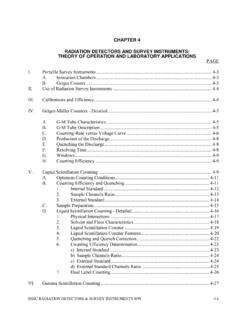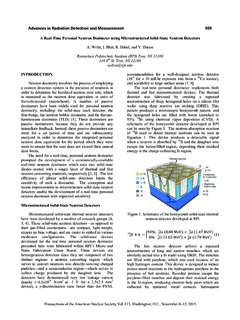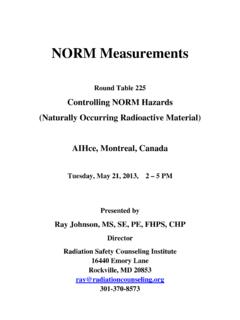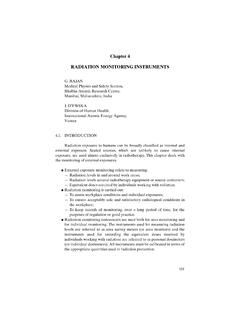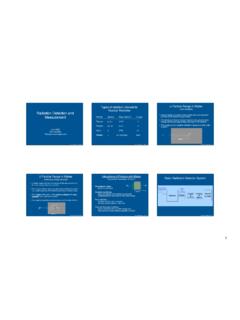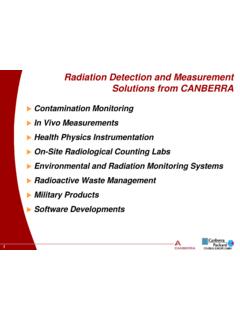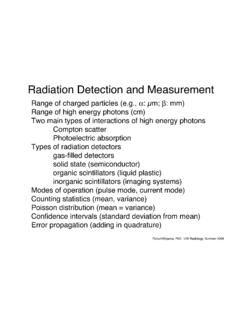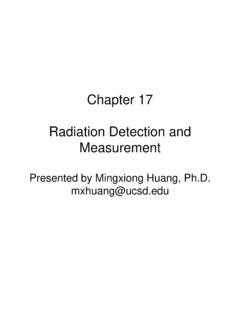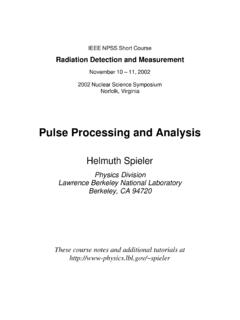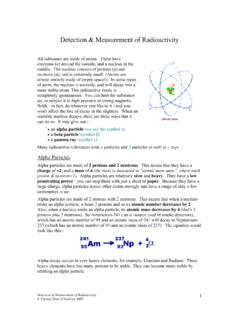Transcription of RADIATION DETECTORS AND SURVEY …
1 RSSC RADIATION DETECTORS & SURVEY instruments 8/99 4-1 CHAPTER 4 RADIATION DETECTORS AND SURVEY instruments : THEORY OF OPERATION AND laboratory applications PAGE I. Portable SURVEY instruments .. 4-3 A. Ionization Chambers .. 4-3 B. Geiger Counter .. 4-3 II. Use of RADIATION SURVEY instruments .. 4-4 III. Calibrations and Efficiency .. 4-4 IV. Geiger-M ller Counters - Detailed .. 4-5 A. G-M Tube Characteristics .. 4-5 B. G-M Tube Description .. 4-5 C. Counting-Rate versus Voltage Curve .. 4-6 D. Production of the Discharge .. 4-8 E. Quenching the Discharge .. 4-8 F. Resolving Time .. 4-8 G. Windows .. 4-9 H. Counting Efficiency .. 4-9 V. Liquid Scintillation Counting .. 4-9 A. Optimum Counting Conditions .. 4-11 B.
2 Counting Efficiency and Quenching .. 4-11 1. Internal Standard .. 4-12 2. Sample Channels Ratio .. 4-13 3. External Standard .. 4-14 C. Sample Preparation .. 4-15 D. Liquid Scintillation Counting - Detailed .. 4-16 1. Physical Interactions .. 4-17 2. Solvent and Fluor Characteristics .. 4-18 3. Liquid Scintillation Counter .. 4-19 4. Liquid Scintillation Counter Features .. 4-20 5. Quenching and Quench Correction .. 4-22 6. Counting Efficiency Determination .. 4-23 a) Internal Standard .. 4-23 b) Sample Channels Ratio .. 4-24 c) External Standard .. 4-24 d) External Standard Channels Ratio .. 4-25 7. Dual Label Counting .. 4-26 VI. Gamma Scintillation Counting .. 4-27 4-2 RSSC RADIATION DETECTORS & SURVEY instruments 8/99 A.
3 Gamma Ray Interactions with Matter .. 4-27 1. Photoelectric Effect .. 4-27 2. Compton Effect .. 4-27 3. Pair 4-28 B. Gamma Scintillation Detector .. 4-28 C. Gamma Scintillation Spectrometer .. 4-30 D. Spectrum Analysis .. 4-32 E. Detector Resolution .. 4-33 RSSC RADIATION DETECTORS & SURVEY instruments 8/99 4-3 RADIATION INSTRUMENTATION I. PORTABLE SURVEY instruments The major principle for sensing and measuring radiations in SURVEY instruments is based on the ionizations RADIATION produces when interacting in a gas filled detector. As described in the previous chapter, radiations passing through matter create ion pairs. In a detector, these ion pairs are collected to form an electrical signal through the use of an electric field.
4 The signal, either a current or a pulse, is then used to register the presence or amount of RADIATION . There are a number of different types of RADIATION DETECTORS , each operating on this basic principle, but designed for specific purposes. The two major types of portable RADIATION SURVEY instruments , the Ion Chamber and Geiger Counter, are discussed below. A. Ionization Chambers Ionization chamber type instruments are designed to measure exposure rates of ionizing radiations in units of mR/hr or R/hr. The detector is usually cylindrical, filled with air and fixed to the display instrument. When RADIATION interacts with the air in the detector, ion pairs are created and collected generating a small current.
5 Since we have defined the Roentgen in terms of the amount of ionization charge deposited in air, measurement of this ionization current will indicate the exposure rate. B. Geiger Counter The most common type of portable RADIATION SURVEY instrument is the Geiger Counter, also know as a Geiger-M ller (G-M) Counter. The G-M counter's detector consists of a tube filled with a mixture of "Q-gas", containing 98% helium and butane. This tube can usually be removed from the display instrument to SURVEY an area. Instead of measuring the average current produced over many interactions, as in Ion Chambers, the output is recorded for each individual interaction in the detector. Thus, a single ionizing event causes the G-M tube to produce a "pulse" or "count".
6 Because all pulses from the tube are the same size regardless of the number of original ion pairs that initiated the process, the G-M counter cannot distinguish between RADIATION types or energies. This is why most G-M counters are calibrated in "counts per minute" (cpm). However, G-M counters can be used to measure exposure rates in mR/hr or R/hr as long as the energy of the x- or gamma RADIATION is known and the instrument is calibrated for this particular fixed energy. At best, for a given x- or gamma ray energy, the count rate will respond linearly with the intensity of the RADIATION field. However, in most applications , the radioactive source will have x- or gamma rays of various energies which can result in erroneous and unreliable readings.
7 Therefore, G-M counters are primarily used to detect the presence of radioactive material. 4-4 RSSC RADIATION DETECTORS & SURVEY instruments 8/99 II. USE OF RADIATION SURVEY instruments RADIATION instruments are designed with a specific purpose in mind. Choose the instrument depending on your particular needs. Generally, Geiger Counters are more sensitive than Ion Chambers at monitoring low levels of contamination in the laboratory . If you wish to measure RADIATION levels in the laboratory , then an Ion Chamber is the proper instrument to use. Each instrument comes with an operating manual that describes its function and limitations such as warm-up time, battery life, operating temperature range, minimum sensitivities, etc.
8 Outlined below are simple instructions on the proper use of portable RADIATION SURVEY instruments . 1. Read the instrument's operating manual. Gain familiarity with the controls and operating characteristics. 2. Check the batteries. Most instruments have a battery check indicator. Replace weak batteries. Turn off the instrument when not in use. When storing the instrument for extended periods, remove the batteries to prevent damage from leakage. 3. Check the operability of the detector. Pass the detector over a radioactive check source (sometimes attached to the side or end of the instrument) to verify that the detector responds to RADIATION . 4. Determine the instrument's response time.
9 By passing the detector at varying speeds over a check source, you can determine how long it takes for the detector to respond to the RADIATION . It is possible to miss contamination or RADIATION fields if the detector is moved too rapidly over the area being surveyed. 5. Determine the operating background. Note the instrument's response in an area free of contamination or RADIATION levels. This is normally due to natural sources of RADIATION called "background". Naturally occurring RADIATION arises from three sources: cosmic rays entering the earth's atmosphere, naturally occurring radioactive materials in the earth's crust, and naturally occurring radioactive materials within the body.
10 Subtract this background value from the "gross" reading to obtain the "net" result due to the sample (S) itself: Snet = Sgross - Sbackground. When using portable instruments , caution should be used when extending detector cords as this may generate electrical noise and register as "counts". Also, the window G-M tubes use to detect alpha and low energy beta particles are fragile and can easily break if dropped or punctured. In a mixed beta-gamma field, the reading due to beta RADIATION only will be the reading with the beta shield off the detector minus the reading with the beta shield on the detector. III. CALIBRATIONS AND EFFICIENCY In order for the results of a SURVEY instrument to be meaningful, the instrument must be calibrated.

